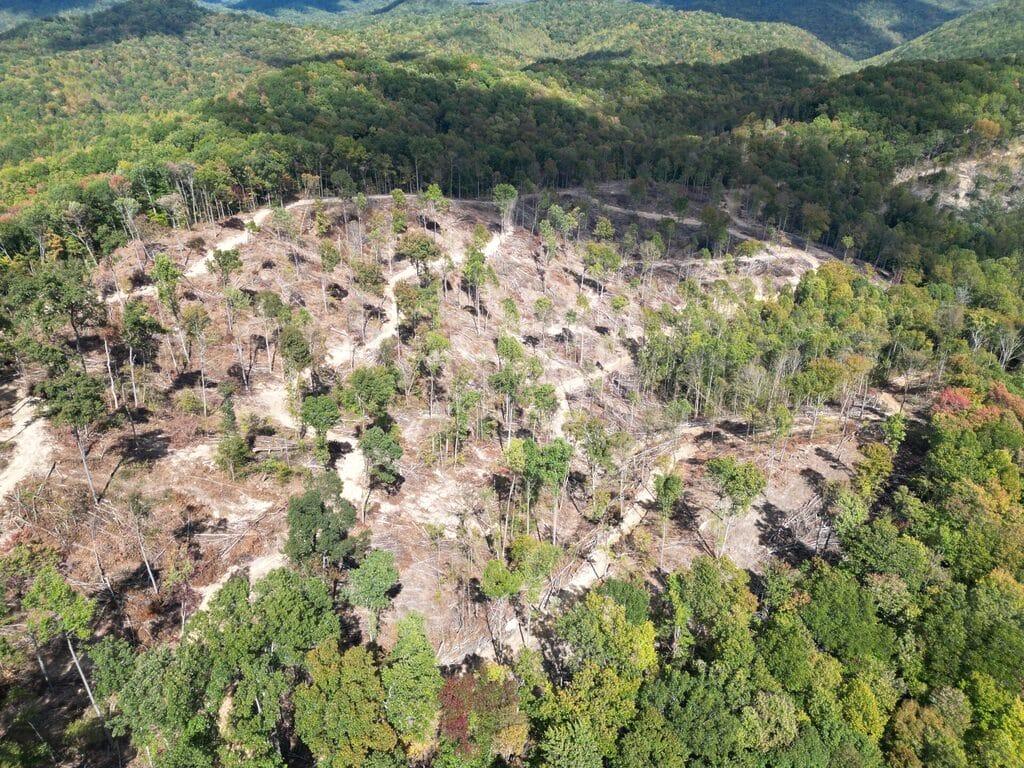Bear Creek Logging Update

What you need to know:
This project is still under a pending lawsuit.
Concerns with slope instability after extraction.
Time is running out for South Redbird.
What you need to know:
This project is still under a pending lawsuit.
Concerns with slope instability after extraction.
Time is running out for South Redbird.

South Red Bird Logging Reconnaissance
Walking through a site that has just been logged makes our hearts hurt, but it is a necessary component of our monitoring work. The following update from our ecologist, Jim Scheff explains the status of Bear Creek from his first hand account. All photos and drone footage are courtesy of Jim and Tina.
I first visited the Bear Creek site on September 2, 2022 after timber had been marked but before the timber had been sold or cut. The forest was lovely, as indicated in the pictures below.


This fall, I visited the Bear Branch sale area again, after most of the trees were cut. I saw:
- Stark and exposed slopes, including large amounts of bare and exposed soil left from the extensive, newly constructed logging roads, turn outs, and log landings
- Cut and exposed root systems, damaged and partially-buried live trees, and slash piles.
- Roots from “leave trees” broken, torn, and exposed.
- Large log landings, turn-outs, and other areas were excavated and graded. Some of these areas already had non-native invasive species growing in them.



I walked through several other logging units in the Bear Creek sale area. Those other units were similarly torn up, with large amounts of skid roads, bulldozed slopes, slash piles, damaged trees, and exposed soil. When I reached an area where work had apparently stopped it was very apparent how much topsoil had been lost. Skid roads that had been partially bulldozed and not fully utilized still had some dark topsoil visible, while all other areas were orange-brown subsoil.
This type of logging leads to a magnitude of carbon emissions:
- Disturbing the soil on a large scale increases soil respiration and causes a great deal of carbon to be released into the atmosphere.
- The piled logging slash will decompose over the next decade and greatly accelerate the amount of carbon being released to the atmosphere.
The two images below are from approximately the same spot, a little over a year apart.


Slope instability
Bear Creek has indications of slope instability in several locations, as indicated on the map below. These indicators include areas of exposed and eroding soil, trees with a “J-curve” base (indicating soil movement during the tree’s growth), trees with significant down-slope root exposure, and a “lumpy” terrain. The numbered yellow arrows point to indications of slope instability which are shown in the pictures as patches of rough or flowing terrain. The below image is sourced from LIDAR.

The limited impacts of these existing features is likely a result of intact root systems from forest cover and the previous lack of bulldozed road benches. The image below, marked by #3 on the LIDAR map, shows the harvest unit Katie’s Creek.

Unfortunately, skid roads now cross both the upper and lower portions of the unstable zone and most of the trees have been removed. Many of the surrounding trees will also likely die over the next 5 to 10 years, thus increasing the potential for more instability.

Damage to “leave-trees”
In all of the harvest areas, I observed significant damage to large numbers of “leave-trees.” These “leave-trees” were marked with orange paint. Damage included large amounts of stripped bark, severed root systems, smothered and compacted root systems, buried tree boles, and broken canopies. Nearly every tree adjacent to a skid road or landing area exhibited damage of a type and severity that will almost certainly lead to decline and tree death over the next several years.
I am very concerned that the decline and death of these designated leave-trees, and especially trees adjacent to skid roads, will further reduce slope stability and leave these areas unnecessarily vulnerable to landslides and erosion.
It is all extremely frustrating and upsetting.
We are moving forward with hiring an on-staff Attorney to continue challenging the Forest Service. Applications are available here and will remain posted until the position is filled. We will begin processing applications on April 1, 2024.
FOR THE FOREST,
Jim Scheff, Kentucky Heartwood Ecologist
Published:

Justice for South Red Bird – Fund our Appeal to the Court!
Hello friends and supporters of Kentucky Heartwood! In September of 2022, Kentucky Heartwood filed a lawsuit challenging the Forest Service’s South Red Bird Wildlife Habitat Enhancement Project, impacting 3,800 acres…

A Legacy Rooted in Passion: Jim Scheff
It is with great love and appreciation that Kentucky Heartwood would like to announce the departure of Staff Ecologist Jim Scheff. Jim’s legacy reshaped the dialogue about forests in Kentucky…


